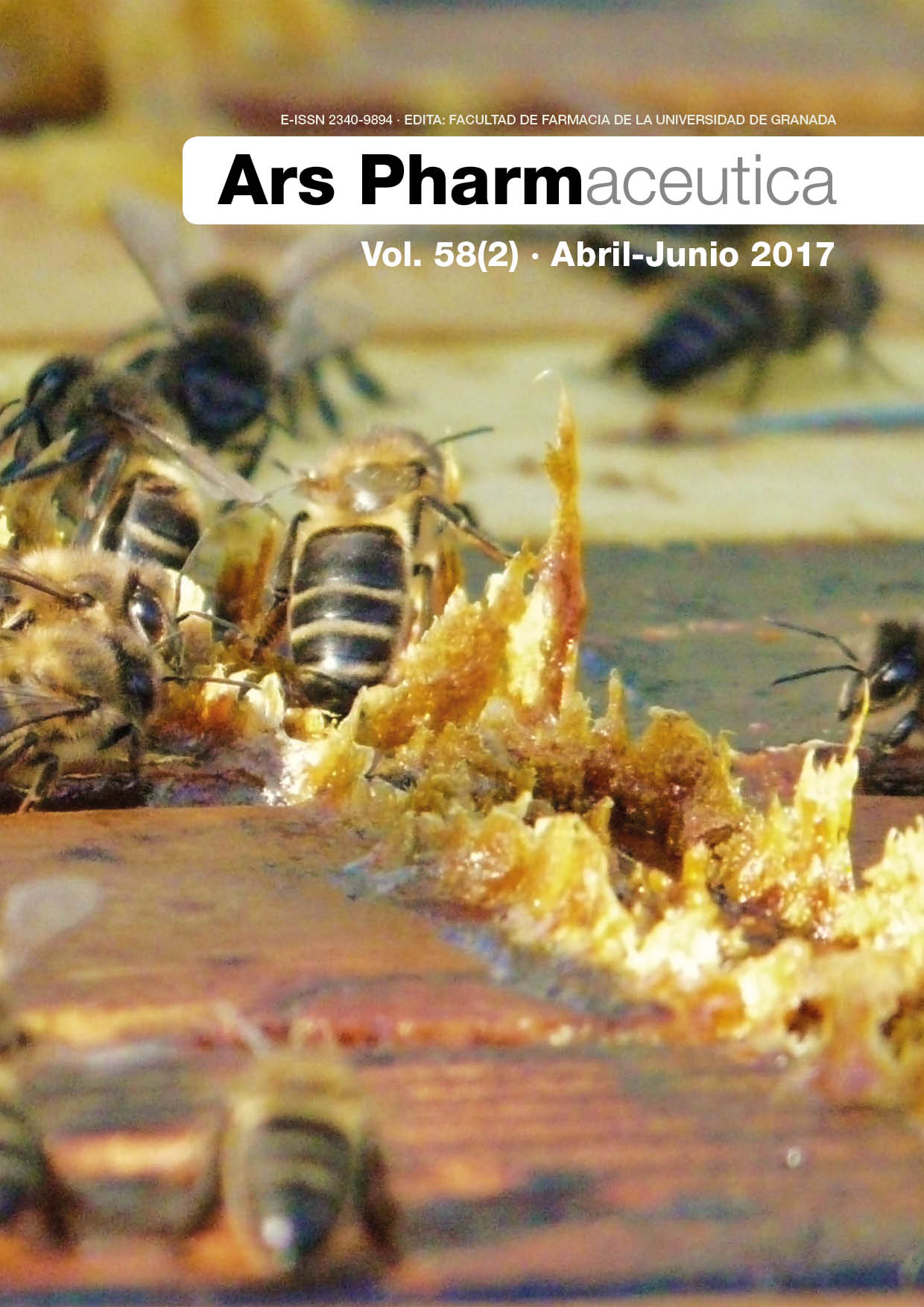Study on the antioxidant and antitumoral activity of propolis
DOI:
https://doi.org/10.30827/ars.v58i2.6382Keywords:
antioxidant, antitumoral, bee, honey, propolis, toxicityAbstract
Introduction: Propolis is the substance that protects the hive, a resin of complex and viscous composition bees use in the repair and protection of the hive. The material from which propolis arises are the resins, shoots and petioles of the leaves of different plants, so it has a very complex chemical composition that varies depending on the flora of the bees collection. It offers an antimicrobial, anti-inflammatory capacity related to its antioxidant, immunomodulatory power, among others.
Aims: In this work, antioxidant and antitumoral activities of different propolis collected from different areas of the province of Malaga, comparing them with one from the Bohemian region to the south of the Czech Republic are studied.
Material and methods: Antioxidant activity was determined according to the ABTS+/S2O8K2 method. In addition, the quantity of total proteins from the nitrogen content and subsequently the cytotoxicity and antitumoral activity of the propolis of Puerto de la Torre, north of Malaga, are measured according to the 3-(4,5-dimetiltiazol-2-il)-2,5-diphenyl tetrazolium bromide method.
Results: It was observed that propolis has high antioxidant activity, although it has a lower amount of proteins. Propolis has high toxicity and higher antitumoral activity against colon cancer than leukemia.
Discussion: With all these data, it can be concluded that propolis offers different activities of interest, for the food and cosmetic industry, among which the high antioxidant and antitumoral capacity.
Downloads
References
Farré R, Frasquet I, Sánchez A. Propolis and human health. Ars Pharm 2004; 45:21-43.
Palomino L, Martínez J, García C, Gil J, Durango D. Caracterización fisicoquímica y actividad antimicrobiana del propóleos en el Municipio de La Unión (Antioquia, Colombia). Rev Fac Nac Agron 2010; 63:5373-5383.
Soto-Vásquez ML. Secondary metabolites, quantification of phenols and total flavonoids of ethanol extracts of propolis from three Peruvian locations. Cien Salud 2015; 6:37-47.
Marcucci MC. Propolis: chemical composition, biological properties and therapeutic activity. Apidologie 1995; 26:83-99.
Bankova VS, de Castro SL, Marcucci MC. Propolis: recent advances in chemistry and plant origin. Apidologie 2000; 31:3-15.
Sforcin JM, Bankova Vassya. Propolis: Is there a potencial for development of new drugs?. J Ethnopharmacol 2011; 133:253-260.
Peña RC. Estandarización en propóleos: antecedentes químicos y biológicos. Cienc Investig Agrar 2008; 35:17-26.
Sforcin J, Orsi R, Bankova V. Effect of propolis, some isolated compounds and its source plant on antibody production. J Ethnopharmacol 2005; 98:301-305.
Fierro Morales W. Capacidad antioxidante de los polifenoles del propóleos. Congreso Internacional sobre Propóleos 2000. Buenos Aires. Argentina (75-85).
Al-Mamary M, Al-Meeri A, Al-Habori M. Antioxidant activities and total phenolics of different types of honey. Nutr Res 2002; 22:1041-1047.
Iwasaki M, Tsugane S. Risk factors for breast cancer: epidemiological evidence from Japanese studies. Cancer Sci 2011; 102:1607-1614.
Kustiawan P, Phuwapraisirisan P, Puthong S, Palaga T, Arung E, Chanchao C. Propolis from the stingless bee Trigona incisa from East Kalimantan, Indonesia, induces in vitro cytotoxicity and apoptosis in cancer cell lines. Asian Pac J Cancer P 2015; 16:6581-6589.
Kumazawa S, Hamasaka T, Nakayama T. Antioxidant activity of propolis of various geographic origins. Food Chem 2004; 84:329-339.
Chen MJ, Chang WH, Lin CC. Caffeic acid phenethyl ester induces apoptosis of human pancreatic cancer cells involving caspase and mitochondrial dysfunction. Int J Pancreatol 2008; 8:566-576.
Salim EI, El-Magid A, Farara KM, Maria D. Antitumoral and antioxidant potential of Egyptian propolis against the PC3 prostate cancer cell line. Asian Pac J Cancer P 2015; 16:7641-7651.
Orsolic N. A review of propolis antitumor action in vivo and in vitro. J Api Prod Apic Med Sci 2010; 2:1-20.
Re R, Pellegrini N, Proteggente A, Pannala A, Yang M, Rice-Evans C. Antioxidant activity applying an improved ABTS radical cation decolorization assay. Free Radic Biol Med 1999; 26:1231-12377.
Kieldahl J. “Neue Methode zur Bestimmung des Stickstoffs in organischen Körpern” (New method for the determination of nitrogen in organic substances). Z Anal Chem 1883; 22:366-383.
Denizot F, Lang R. Rapid colorimetric assay for cell growth and survival. Modifications to the tetrazolium dye procedure giving improved sensitivity and reliability. J Immunol Methods 1986; 89:271-277.
Jerez CG, Malapascua JR, Sergejevová M, Masojídek J, Figueroa FL. Chlorella fusca (Chlorophyta) grown in thin-layer cascades: estimation of biomass productivity by in-vivo chlorophyll a fluorescence monitoring. Algal Res 2010; 17:21-30.
Kumazawa S, Bonvehí J, Torres C, Mok-Ryeon A, Orantes F. Chemical and functional characterization of propolis collected from East Andalusia (Southern Spain). Phytochem Analysis 2013; 24:608-615.
Salatino A, Weistein Teixeira E, Negri G, Message D. Origin and chemical variation of Brazilian propolis. Evid Based Complement Alternat Med 2005; 2:33-38.
Cuéllar A, Rojas NH, Hovet S. Composición química del propóleos cubano II. Rev Cubana Farm 1990; 27:27-31.
Murtaza G, Karim S, Akram MR. Caffeic acid phenethyl ester and therapeutic potentials. Biomed Res Int 2014; 2014:145342.
Kimoto T, Aga M, Hino K. Apoptosis of human leukemia cells induced by Artepillin C, an active ingredient of Brazilian propolis. Anticancer Res 2001; 21:221-228.
Downloads
Published
How to Cite
Issue
Section
License
The articles, which are published in this journal, are subject to the following terms in relation to the rights of patrimonial or exploitation:
- The authors will keep their copyright and guarantee to the journal the right of first publication of their work, which will be distributed with a Creative Commons BY-NC-SA 4.0 license that allows third parties to reuse the work whenever its author, quote the original source and do not make commercial use of it.
b. The authors may adopt other non-exclusive licensing agreements for the distribution of the published version of the work (e.g., deposit it in an institutional telematic file or publish it in a monographic volume) provided that the original source of its publication is indicated.
c. Authors are allowed and advised to disseminate their work through the Internet (e.g. in institutional repositories or on their website) before and during the submission process, which can produce interesting exchanges and increase citations of the published work. (See The effect of open access).























